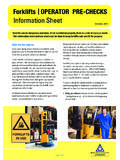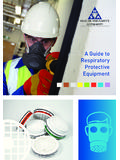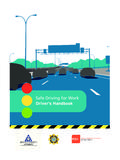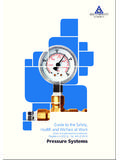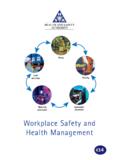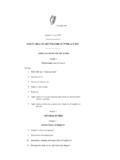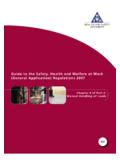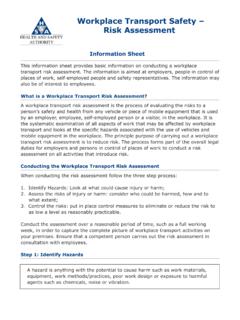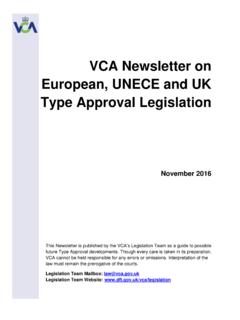Transcription of Hazard Labelling & Packaging according to the CLP …
1 Hazard Labelling & Packaging according to the CLP Regulation May, 2014. Information Sheet The Classification, Labelling and Packaging (CLP) Regulation covers hazardous chemicals sold to professional users and consumers. This information sheet outlines the key requirements for the Labelling and Packaging of hazardous chemicals under the CLP Regulation. All hazardous chemicals (substances and mixtures) legally harmonised (agreed) classifications which are placed on the market must be classified, labelled and listed in Annex VI of the CLP Regulation. packaged according to the CLP Regulation (EC) No. 1272/2008 by 1st June 2015. If a chemical substance does not have a classification The responsibility for Labelling and Packaging of listed in Annex VI, then the manufacturer or hazardous substances and mixtures lies with: importer is legally obliged to examine all relevant available information against the CLP classification manufacturers of substances, criteria and self classify the hazardous substance when importers of substances or mixtures, it meets the criteria.
2 Formulators of mixtures, and Similarly, formulators or importers of mixtures must distributers or Downstream Users, who do not examine all relevant available information against the reformulate or change the substances or mixtures CLP classification criteria and self classify hazardous but relabel/repackage them. mixtures. Exemptions from CLP Once the chemicals hazards are identified, communication of these hazards must be provided Waste and cosmetics, medicines, medical devices, on the Hazard label and the chemical must be contained veterinary products, foodstuffs or animal feed which in Packaging that meets the requirements of CLP. are in their finished state, intended for the final user are not covered by the CLP Regulation Classification of hazardous Substance/Mixtures: The physical properties along with health and environmental effects of chemicals must be identified and evaluated to determine if they need to be classified.
3 Some hazardous chemical substances have Page 1. Hazard Labelling & Packaging according to the CLP Regulation Information Sheet Labelling of hazardous Layout and dimensions of Substances/Mixtures: the Hazard Label: A Hazard label must contain the following elements The label must: applicable to the substance or mixture placed on the be firmly attached to the surface of the product, market as shown in figure 1. be visible, legible and readable in English, and have the following dimensions: name, address and telephone number of the EU supplier(s), product identifiers chemical name and Capacity of the Dimensions of label CAS/EC no. of the substance/trade name of a package (mm). mixture along with the chemical name(s) of all substances responsible for classification of the 3 litres If possible at least 52 x 74.
4 Mixture (excluding skin and eye irritants), Hazard pictogram(s1):signal word: either > 3 litres but 50 litres At least 74 x 105. Warning or Danger depending on the > 50 litres but 500 litres At least 105 x 148. classification Hazard statement(s) description of the > 500 litres At least 148 x 210. hazardous effect Harmful if inhaled, the appropriate precautionary statements to allow the user of the chemical to take measures have all the Hazard pictograms, signal word, to protect health/environment Keep out of Hazard and precautionary statements together, reach of children, have, where more than one language is used, nominal quantity (when the chemical is all the Hazard and precautionary statements of supplied to the general public), and the same language grouped together, supplemental information.
5 Ensure that the Hazard pictogram stands out clearly (black print on white background Obligatory supplemental information includes surrounded by red frame being at least one Hazard statements taken from the previous chemical fifteenth and at least 1 cm2 of the label), and legislation EUH001 Explosive when dry and have no blank pictograms (where blank EUH204 Contains isocyanates. May produce an pictograms are unavoidably printed on the label allergic reaction . they should be blacked out). Non-obligatory supplemental Labelling information, for example, instructions for use is not part of the legal Labelling requirements under CLP. However, if provided it must not distract from nor contradict the obligatory label elements, Hazard and precautionary statements.
6 Statements such as non- toxic', non-polluting' may not be used on labels. The Hazard information on the label must be consistent with the classification in Section and the label elements in Section of the Safety Data Sheet (SDS) provided for the same product. 1. free of charge for download from the website Page 2. Hazard Labelling & Packaging according to the CLP Regulation Information Sheet Figure 1: Example of Hazard Label for Supply Product identifier must be identical to that used in the SDS. For substances Hazard this will be the chemical name and CAS. Pictograms shaped number or EC number. as a diamond with black symbol on a white background SUBSTANCE XYZ-123. with a red border. CAS No. xxxx-xx-x Must cover at least one fifteenth of surface area of label, Supplier but not be less than details.
7 1cm2. name, address Supplier: XYZChem Ltd. Danger Cosy Lane, and tel. no. Signal word Flammable liquid and vapour Dublin 123. May be fatal if swallowed and enters airways Tel. No. 01 123 4567. Causes skin irritation Hazard Statements May cause drowsiness or dizziness Toxic to aquatic life with long lasting effects Keep out of reach of children. Precautionary Keep away from heat/sparks/open flames/hot surfaces. No smoking. Statements Store in a well-ventilated place. maximum of 6 on the Wear protective gloves/protective clothing/eye protection/face protection. label. All relevant IF SWALLOWED: Immediately call a POISON CENTER or doctor/physician. precautionary Do NOT induce vomiting. Nominal IF INHALED: Remove victim to fresh air and keep at rest in a position statements should comfortable for breathing.
8 Quantity . be in the SDS. required where product is sold to the general Non-obligatory 2L public. supplemental information recycling information. Updating the Hazard Label The label should be updated without undue delay, Other required label changes change in supplier when there is a change in classification of the substance address shall be done within 18 months of the or mixture which results in a more severe Hazard or required change. Suppliers should cooperate to ensure where new supplemental information is required on that labels are updated without undue delay. the label taking account of the nature of the change. Page 3. Hazard Labelling & Packaging according to the CLP Regulation Information Sheet Labelling of workplace chemicals Derogations from Labelling The requirement for a CLP Hazard label is dependent Derogations from Hazard Labelling requirements are on whether the chemical is being placed on the permitted in special cases including transportable market or not, noting that import is deemed to be gas cylinders, gas containers intended for propane, placing on the market'.
9 Butane or liquefied petroleum gas, certain aerosols, certain mixtures containing elastomers and explosives. All incoming or outgoing chemicals to or from a (See section Annex I of the CLP Regulation for workplace require a CLP Hazard label if they are further details). being placed on the market'. Therefore, all incoming chemicals to a workplace should be labelled by the Exemptions from Labelling supplier, and all outgoing chemicals from a workplace equally should be labelled before being placed on the Certain Labelling elements may be omitted where the market. contents do not exceed 125ml, depending on the Hazard classification of the substance or mixture (see However, for chemicals produced and used within Section Annex I of the CLP Regulation for further a workplace' the situation is different, because they are details).
10 Stored and transported within the workplace and not being placed on the market in containers and Where Packaging is either in such a shape or form or pipe work on site, the CLP Hazard Labelling rules do not so small as to not allow the necessary Hazard Labelling apply. information to fit on the label, derogation exists. In such cases and where applicable, the label elements However, there is still a requirement to ensure a may be provided either on: risk-based approach is undertaken to determine any potential hazards from such chemicals produced, fold-out labels, or on stored, transported and used within the workplace. tie-on tags, or on This may result in a requirement to produce an outer Packaging . in-house' Hazard label. With the exception of biocides and plant protection Such workplace chemicals come under the remit products, all label elements for certain Hazard classes of the Chemical Agent and Work Place Signs which do not exceed 25ml may be omitted from regulations .

